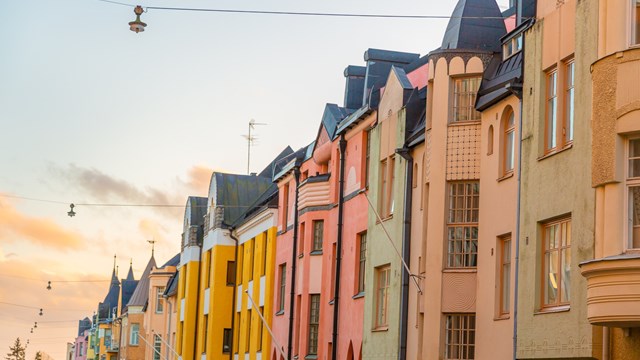As the push to reduce our carbon emissions and maintain livable conditions intensifies, sustainability has become an increasingly important concern for multifamily buildings—including condos, co-ops, and HOAs. More and more legislation and regulation from the federal to local level are focused on keeping earth inhabitable, effectively forcing the hand of communities that haven’t yet decided how to approach the issue in their buildings. Legal caps on building emissions—and steep fines for those that don’t comply—have many boards and property professionals at a loss as to how to navigate the challenges of implementing sustainability-focused upgrades and retrofits without exceeding capital budgets or significantly raising carrying charges for their residents.
It’s the Law
New York City was among the first municipalities in addressing the climate crisis, as well as among the most ambitious, releasing a broad set of initiatives in 2007 aimed at environmental improvements that would reach far beyond the five boroughs. The Climate Mobilization Act (CMA) of 2019 was an achievement borne of that plan, with the ultimate goal of making the Big Apple carbon neutral by 2050. Its series of Local Laws have major implications for the city’s 1 million-plus buildings, the operation of which is responsible for about 70% of the city’s carbon emissions.
Roughly half of those emissions come from the 50,000 or so buildings over 25,000 square feet, which is why the CMA’s linchpin, Local Law 97 (LL97), targets them by setting emissions limits by occupancy type that get more stringent over time, starting next year. It also sets fines for exceeding those limits—$268 per metric ton of CO2 equivalent annually—that come due starting in 2025.
According to the city’s 2023 climate action plan, PlaNYC: Getting Sustainability Done, based on current data, only 21% of buildings to which the law applies won’t comply with the 2025 limits. And half of those are 15% or less over their emissions limit, according to John Mandyck, CEO of building-decarbonization nonprofit Urban Green Council—making it possible for them to comply through “common-sense energy efficiency measures,” he says, which include fairly straightforward things like switching incandescent light bulbs to LEDs, repairing faulty windows, etc.
But achieving 2030–2050 limits? That’s what has many multifamily boards and property professionals throwing up their hands.
It’s a Conundrum
Although an entire industry has sprung up in response to these new and evolving laws with the stated intent of helping buildings achieve compliance, it hasn’t been so simple in practice. As detailed in a recent article in The City, a town hall on the topic hosted this past June by Councilmember Sandra Ung (D-Flushing) featured representatives from NYC Accelerator—a program for building owners and operators “to learn about energy efficiency improvements and financing options that can help you comply with NYC’s building laws, reduce operating costs, and gain community recognition” for free, per its website—as well as the Department of Buildings Bureau of Sustainability.
Many in attendance were from Queens’ 1,500 (give or take) co-ops and condos, including Michelle Lee, president of the 1,200-unit Sky View Parc condominium association. After pressing Accelerator reps, she learned that the program does not itself provide energy audits or financing—it can only refer building owners to qualified firms that do.
“That’s the thing,” Lee tells The City. “There’s a lot of misleading information out there about how ‘you get everything for free, you just haven’t reached out to us.’ That’s certainly not true.”
So before even embarking on costly retrofits, a building or complex first needs to invest in the consultations that will determine what retrofits they actually need to meet the various compliance thresholds. Lee tells The City that her board has already spent around $200,000 on hiring an energy consultant who determined that the complex is 2025 compliant, which has resulted in common-charge increases that are a stretch for residents on fixed incomes, such as the many retirees in the building. Meeting 2030 compliance might result in costs untenable for many homeowners.
This rings especially true for the city’s co-ops that began as or are now home to working-class families, veterans, and naturally occurring retirement communities, or NORCs. Glen Oaks Village in Queens, with 3,000 co-op units built as affordable housing for WWII veterans, has already spent $100,000 on an energy consultant, who concluded that the complex’s 94 gas-and-oil boilers will need to be replaced to comply with LL97 as soon as next year. The cost? An estimated $24.5 million—a little more than $8,100 per household.
Even with that upgrade, which president Bob Friedrich estimates will take five to ten years to complete, the co-op won’t meet 2030 standards. At that point, they are looking at fines of nearly $1 million each year, which would translate into annual maintenance increases of up to 10%—even without factoring in other rising operating costs.
For example, according to the co-op’s energy consulting firm Bright Power, changing over to an electric heat pump system would get the co-op closer to full compliance, lower its utility bills, and offer a cleaner, greener means of providing heat and hot water to residents. But it would also cost an additional $10 million that the co-op doesn’t have, even with the up to 40% tax credit that the Biden administration’s Inflation Reduction Act of 2022 promises to provide for the cost of the ground loop, heat pumps, and related HVAC equipment.
At an earlier Queens town hall in May that was attended by more than 400 residents, according to local outlet QNS, Councilmember Vickie Paladino (R-Whitestone) solicited support for her proposal Intro 913 that seeks a seven-year delay in enacting LL97. Without diminishing the climate crisis or buildings’ role in it, she contended that “giving ourselves a longer time frame for implementation [of LL97] would help ensure lower costs, better results, and a cleaner planet” at the meeting.
“The technology is advancing rapidly,” she said to the motivated crowd, but a delay would allow it “to catch up with the requirements of Local Law 97, bring costs down, and, most importantly, allow for implementation in an economically feasible manner that helps our environment.”
Paladino, along with leaders of the Presidents Co-op & Condo Council (PCCC), of which Friedrich is co-president and among the plaintiffs in a pending lawsuit seeking to prevent the enactment of LL97, urges building owners and residents to ask their councilmember to sign Intro 913.
It’s Doable
A handful of other U.S. municipalities have followed NYC’s lead with similar legislation—but not necessarily similar pushback. According to Celine Damide, a clean energy data analyst at Brightcore Energy, a provider of clean energy solutions for buildings throughout the Northeast, the city of Boston passed a revised Building Emissions Reduction and Disclosure Ordinance (BERDO) in 2021 requiring large buildings to reach zero emissions by 2050. “Like New York City’s infamous Local Law 97,” Damide says, “the new BERDO requires buildings to comply with carbon emission limits or face high penalties. … Most buildings will have to undergo deep energy retrofits to comply with sharply increasing compliance standards.” (San Francisco, St. Louis, and Washington, D.C. are the other U.S. cities with comparable laws on the books.)
Perhaps unlike New York, Boston has been proactive in fostering partnerships among real estate professionals, community organizers, climate advocates, and everyday Bostonians to push its decarbonization agenda forward. At a Bisnow Construction & Development event in Beantown in March, Boston’s carbon neutrality director Hannah Payne told attendees, “We want to understand what challenges you’re all facing and understand how we can streamline our program policies to set those expectations so that you can make those plans.” She tells Bisnow that these public-private relationships are crucial to determining what types of policies are actually feasible. Educating everyone—from residents to developers—on the city’s sustainability effort is the cornerstone to achieving goals set through BERDO and other net-zero initiatives.
On a micro level, getting nonprofit multifamily communities to commit to multi-million-dollar projects that are not necessarily what the real estate industry likes to call “sexy” is really where the buck stops. Record inflation, uncertain political times, and abundant misinformation leave a lot of residents skeptical about investing their housing dollars into something that protects a theoretical future. Reaching these homeowners—or at least the boards elected to make decisions for their communities—is the key.
A shining example of success in this realm is Sherman Terrace Cooperative (STC) at 1010 Sherman Avenue in the Bronx. The 67-unit building was developed in 1957 and has been home to a majority minority low- and medium-income population ever since. It has been led in a progressive direction by board newcomer Derek Jones, who brought big ideas and a background in project management to the board when elected to it in 2019. Working with energy consultancy EN-POWER GROUP, Jones and his six fellow directors embarked on an ambitious plan to reduce energy use, lower costs, and minimize the building’s carbon impact by installing a new gas boiler with a Real Time Energy Management (RTEM) system along with smart temperature sensors in more than one-third of the apartments, a separate 750,000 BTU hot water heater, and submetering for each apartment “to create an opportunity for shareholders to become more aware of their personal energy usage,” says Jones.
Thinking ahead, STC also insulated its roof “with a two-inch ISO sealed with a 60-ml TPO membrane, so the building remains cooler in the summer and retains heat in the winter,” says Jones. He notes that the roof has a 25-year warranty, making it the perfect setting for what he calls “the pièce de résistance”: 301 LG solar photovoltaic modules that generate over 120,000 KWh annually, covering about 1/3 of the co-op’s electric consumption.
Their proactiveness is already paying dividends. Mitchell Karasik, EN-POWER’s director of business development, says that in 2018, STC’s ENERGY STAR score was a 36, with a letter grade that would have been a D—and an annual carbon penalty of $6,201 starting in 2024, and $63,667 starting in 2030. “As the building implemented measures such as an oil-to-gas conversion, lighting, solar, and boiler controls,” he continues, “it reduced costs for the cooperative, eliminated its 2024 and 2030 carbon penalties—completely!—and improved its letter grade to an A.”
But STC isn’t stopping there. Addressing water conservation is the next order of business, Jones reports. The co-op has already reduced its lawn footprint and replaced plants with more drought-tolerant foliage in response to the water crisis out West and around the world, he says. His next goal is to replace each unit’s toilet with an efficient dual-flush model that uses half the amount of water, offering an ROI of merely one year. They’re just looking for a program or grant that would make the upfront cost feasible. They are also exploring the enhanced green roof property tax abatement and are about to begin a Low-Carbon Capital Planning Support survey that the New York State Energy Research & Development Authority (NYSERDA) offers to multifamily buildings.
“We want to chase rebates, tax breaks, and incentives instead of chasing remediation of violations—and just maybe set a positive, proactive, conscious example for the surrounding community to follow,” Jones says.
It’s Necessary
Regardless of how and when it’s implemented, LL97 and its ilk must be accomplished to even begin to achieve the emissions reductions necessary to prevent Earth from skidding into irreversible ruin. The multifamily buildings complying with the laws will not only be doing their part to save the planet—they will also reduce their utility costs; create cleaner, healthier air for their communities; and increase their property values and desirability.
“Local Law 97 is tough but doable,” says Urban Green Council’s Mandyck. “We have no choice but to move forward; the climate isn’t waiting for us to act.”
Darcey Gerstein is Associate Editor and a Staff Writer for CooperatorNews.










Comments
Leave a Comment